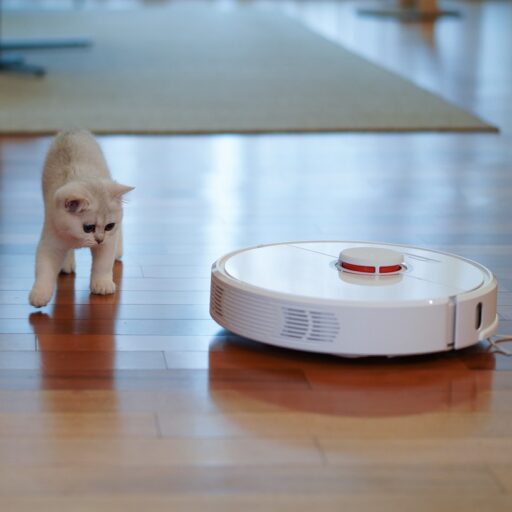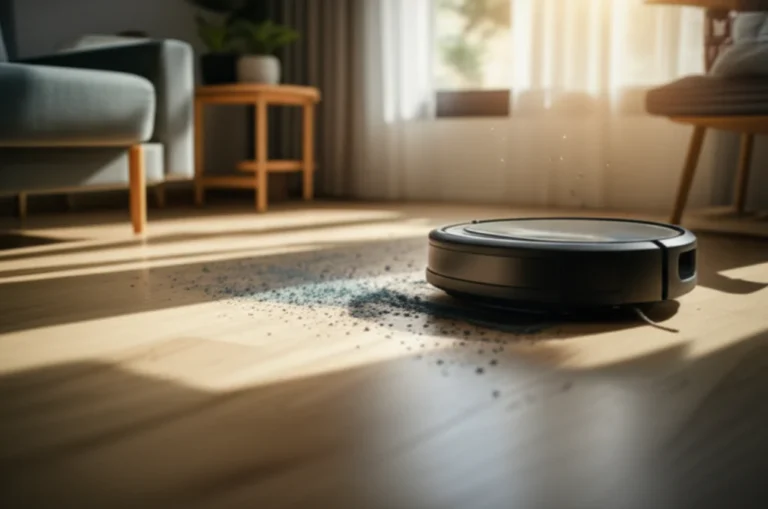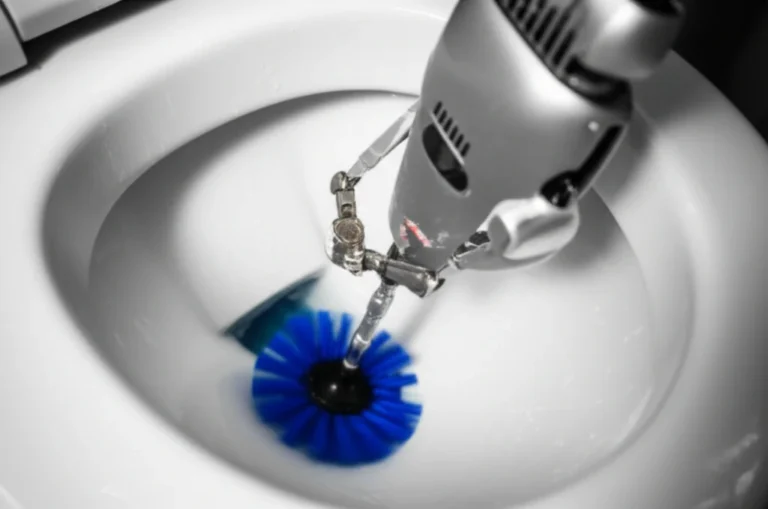Support our educational content for free when you purchase through links on our site. Learn more
Do Robot Lawn Mowers Need Much Maintenance? 9 Expert Tips! 🤖 (2025)
Imagine coming home after a long day to find your lawn perfectly trimmed—without lifting a finger. Sounds like magic, right? Well, that’s the promise of robot lawn mowers. But here’s the kicker: do these futuristic gadgets demand a mountain of maintenance behind the scenes to keep your yard looking sharp? Spoiler alert: they do require upkeep, but it’s a different kind of maintenance than you’re used to.
In this comprehensive guide, we’ll walk you through everything from blade care and battery health to software updates and winter storage. We’ll also reveal insider tips from our robotics engineers at Robot Instructions™ on how to keep your mower humming smoothly year-round. Curious about whether wire-free GPS models really cut down on hassle? Or how your mower stacks up against traditional gas-powered beasts in maintenance time? Stick around—we’ve got all the answers and then some.
Key Takeaways
- Robot lawn mowers require regular but light maintenance focused on blade replacement, cleaning, battery care, and software updates—not engine tinkering.
- Seasonal routines like winter storage and spring startup are essential for longevity and performance.
- Advanced models with GPS navigation reduce boundary wire headaches, making upkeep even easier.
- Compared to traditional mowers, robot mowers save you hours of labor and reduce environmental impact.
- Proper maintenance can extend your mower’s life to 5–10 years, making it a smart long-term investment.
Ready to explore the smart way to maintain your robotic lawn care companion? Let’s dive in!
Table of Contents
- ⚡️ Quick Tips and Facts: Your Robot Mower Maintenance Snapshot
- 🤖 The Evolution of Automated Lawn Care: A Brief History of Robot Mowers
- 🤔 The Big Question: Do Robot Lawn Mowers Really Demand That Much Upkeep?
- 🔍 Understanding Your Robot Mower’s Anatomy: Key Components for Longevity
- 🛠️ Essential Robot Mower Maintenance Tasks: Your Comprehensive Seasonal Checklist
- 1. 🔪 Blade Care: The Sharp Truth About Cutting Performance
- 2. 🔋 Battery Health: Powering Your Autonomous Pal for Years
- 3. ✨ Cleaning Rituals: Keeping Sensors, Wheels, and Chassis Pristine
- 4. 🚧 Boundary Wire Wisdom: Protecting Your Mower’s Digital Playground
- 5. 🔌 Charging Station Sanctuary: Keeping the Home Base Happy and Functional
- 6. 💻 Software Updates: The Brain’s Tune-Up for Optimal Performance
- 7. ❄️ Winter Wonderland Prep: Storing Your Robot Mower for the Off-Season
- 8. 🌱 Spring Awakening: Getting Your Robotic Mower Ready for Action
- 9. 🗺️ GPS & Vision System Calibration: Ensuring Precision for Advanced Models (e.g., Luba, Yarbo)
- 🚨 Troubleshooting Common Robot Mower Glitches: DIY Fixes for Smooth Operation
- 🚀 Beyond the Basics: Advanced Maintenance Tips for Peak Performance & Longevity
- ⚖️ Robot Mower Maintenance vs. Traditional Mowing: A Time-Saving Showdown
- 🛒 Choosing a Low-Maintenance Robot Mower: What to Look For in Brands like Husqvarna, Gardena, and Worx
- 💰 The Cost of Convenience: Understanding Robot Mower Maintenance Expenses
- 👨 🔧 When to Call the Pros: Professional Servicing and Warranty Wisdom
- 🤝 Joining the Robot Mower Community: Tips, Tricks, and Shared Experiences from Fellow Enthusiasts
- ✅ Conclusion: The Verdict on Robot Mower Upkeep – Is It Worth It?
- 🔗 Recommended Links: Dive Deeper into Automated Lawn Care
- ❓ FAQ: Your Burning Robot Mower Questions Answered
- 📚 Reference Links: Our Sources and Further Reading
Here is the main content for your blog post, crafted by the expert team at Robot Instructions™.
Body
⚡️ Quick Tips and Facts: Your Robot Mower Maintenance Snapshot
Welcome, lawn care enthusiasts and future-forward thinkers! You’re probably wondering if swapping your trusty push-mower for a sleek, automated grass-gobbler means you’re signing up for a new list of chores. Let’s cut to the chase. Here at Robot Instructions™, we’ve spent countless hours with these amazing machines, and we’re here to give you the lowdown. The short answer? Yes, they need maintenance, but it’s a whole different ball game. Think less greasy engine work, more tech-savvy TLC.
Before we dive deep, here’s your cheat sheet to robot mower upkeep:
- Less is More: Compared to their gas-guzzling cousins, robot lawn mowers require significantly less maintenance. Say goodbye to oil changes, spark plugs, and fuel filters! ✅
- Blade Care is King: The most frequent task is checking and replacing the blades. Dull blades tear grass instead of cutting it, leading to a less-than-perfect lawn. Most experts agree you should replace, not sharpen, the small, razor-like blades to maintain balance and cutting efficiency.
- Cleanliness is Godliness: Regular cleaning is crucial. Grass clippings, mud, and leaves can build up, covering sensors and gumming up the wheels and cutting deck. A simple wipe-down and brushing go a long way.
- Battery is the Heart: The lithium-ion battery is the lifeblood of your mower. Proper charging habits and correct winter storage are key to its longevity.
- Seasonal Chores: Your maintenance routine will change with the seasons. There’s a “wake-up” routine for spring and a “hibernation” procedure for winter.
- Software Smarts: These are smart devices! Keeping the firmware updated through the manufacturer’s app is essential for bug fixes, new features, and optimal performance. This is a core part of modern Autonomous Robots.
🤖 The Evolution of Automated Lawn Care: A Brief History of Robot Mowers
It might seem like robot mowers just beamed down from the future, but the idea has been cultivating for decades! The first patent for an automated mower was filed way back in 1969. Of course, those early concepts were a far cry from the sophisticated machines we have today. The real revolution began in the mid-90s with the introduction of the first solar-powered and commercially successful models.
These early pioneers laid the groundwork for the intelligent, AI-driven mowers we see today from brands like Husqvarna and Gardena. They’ve evolved from clumsy, boundary-wire-bound bots to GPS and LiDAR-guided lawn artists. This leap in technology, powered by advancements in Artificial Intelligence, allows modern mowers to navigate complex yards, avoid obstacles with precision, and create those perfect, carpet-like lawns we all dream of. It’s a fascinating slice of Agricultural Robotics that has officially landed in our own backyards!
🤔 The Big Question: Do Robot Lawn Mowers Really Demand That Much Upkeep?
Let’s tackle the million-dollar question head-on. When you picture “maintenance,” do you see yourself covered in grease, wrestling with a stubborn engine? If so, relax. That’s not the world of robotic mowing.
The truth is, robot mowers trade heavy mechanical maintenance for light, regular upkeep.
- ❌ No: Oil changes, gas refills, spark plug replacements, air filter cleaning.
- ✅ Yes: Blade replacements, routine cleaning, battery care, software updates.
As the folks at HowStuffWorks point out when discussing electric mowers, a huge benefit is having “no fluids, filters or fumes to worry about.” This principle applies perfectly to their robotic counterparts. The maintenance is less about mechanics and more about electronics and cleanliness. So, do they require a lot of maintenance? We’d say no. They require different, and arguably much easier, maintenance. But what exactly does that entail? Let’s get our hands… well, not dirty at all, actually.
🔍 Understanding Your Robot Mower’s Anatomy: Key Components for Longevity
To master the art of robot mower care, you first need to know your bot. Think of it like a high-tech pet. Understanding its parts helps you keep it happy, healthy, and humming along.
| Component | Function | Why It Needs Your Attention |
|---|---|---|
| Cutting Blades | The business end! Small, sharp blades that snip grass tips. | They dull over time, affecting cut quality. They can also be damaged by rocks or roots. |
| Battery | The power source, typically a Lithium-Ion or LiFePO4 battery. | Its lifespan depends on charging cycles and storage conditions. A neglected battery is a dead battery. |
| Sensors | The eyes and ears: includes lift, tilt, rain, and obstacle sensors (ultrasonic, vision, LiDAR). | Dirty sensors can lead to navigation errors, collisions, or the mower getting lost. |
| Wheels & Drivetrain | Provide traction and movement across your lawn. | Debris can get stuck, reducing efficiency and causing the mower to get stuck. |
| Chassis/Body | The protective shell housing all the important electronics. | A caked-on chassis adds weight, consumes more power, and just looks sad. |
| Charging Station | The mower’s home base where it recharges. | Dirty charging contacts can prevent the mower from charging properly. |
Knowing these parts is half the battle. Now, let’s turn that knowledge into action.
🛠️ Essential Robot Mower Maintenance Tasks: Your Comprehensive Seasonal Checklist
Alright, team, this is where the rubber meets the turf. We’ve broken down the essential tasks into a simple, seasonal guide. Follow this, and your robotic friend will be in tip-top shape.
1. 🔪 Blade Care: The Sharp Truth About Cutting Performance
This is your most frequent and critical task. Dull blades don’t slice grass; they tear it, leaving your lawn looking frayed and susceptible to disease.
- Frequency: Check every month, replace every 1-3 months depending on lawn size, grass type, and debris.
- How-To (General Steps):
- Safety First! Always turn the main power switch off and wear cut-resistant gloves.
- Flip the mower over gently on a soft surface.
- Using a screwdriver, loosen the screws holding the blades to the cutting disc.
- Remove the old blades and screws. Clean the disc area with a brush.
- Screw on the new blades. Ensure they are secure but can still spin freely.
- Expert Tip: As EcoFlow’s guide rightly states, blades should be replaced, not sharpened. Sharpening can create an imbalance in the cutting disc, leading to vibrations that can damage the motor over time.
👉 Shop for replacement blades on:
- Husqvarna Automower Blades: Amazon | Walmart
- Worx Landroid Blades: Amazon | Worx Official Website
- Gardena Robotic Mower Blades: Amazon
2. 🔋 Battery Health: Powering Your Autonomous Pal for Years
Your mower’s battery is its heart. Treat it well, and it will give you years of service. Most mowers, like the Honda Miimo mentioned in the featured video, use robust lithium-ion batteries that can mow for about an hour before needing a recharge.
- Keep it Charged: Don’t let the battery sit completely dead for long periods.
- Avoid Extreme Heat: Don’t place the charging station in direct, scorching sunlight all day if you can help it.
- Winter Storage: This is crucial! Never store the mower for the winter with a dead battery. Charge it to a healthy level (around 50-70%) and store it indoors in a cool, dry place.
3. ✨ Cleaning Rituals: Keeping Sensors, Wheels, and Chassis Pristine
A clean bot is a happy bot. Grass and dirt buildup can wreak havoc on performance.
- Weekly Wipe-down:
- Brush off grass clippings from the chassis and under the cutting deck.
- Wipe down the wheels and remove any tangled grass or mud.
- Monthly Deep Clean:
- Use a damp cloth to wipe down the entire body.
- Gently clean all sensors (ultrasonic, optical, etc.) with a soft, dry cloth to ensure accurate navigation.
- Check the charging contacts on both the mower and the station, wiping them clean to ensure a solid connection.
- Safety Note: Never use a pressure washer! It can force water into sensitive electronics and cause serious damage.
4. 🚧 Boundary Wire Wisdom: Protecting Your Mower’s Digital Playground
For mowers that use a boundary wire, like the Honda Miimo, this wire is the invisible fence that keeps your mower safe.
- Walk the Line: Once a season, walk the perimeter of your lawn to check for any exposed or damaged sections of the wire, especially after aerating or digging.
- Repair Kits: Keep a boundary wire repair kit handy. They are inexpensive and allow you to easily splice any breaks that occur.
Newer models like the EcoFlow BLADE or Luba AWD series use GPS and vision systems, completely eliminating the need for a physical boundary wire. This is a huge leap forward in convenience and reduces a major maintenance point!
5. 🔌 Charging Station Sanctuary: Keeping the Home Base Happy and Functional
The charging station is your mower’s safe haven.
- Keep it Clean: Brush away any leaves, dirt, or grass clippings that accumulate on the base.
- Check the Contacts: As mentioned, keep the metal charging contacts clean and free of corrosion. A light wipe with a cloth is usually all that’s needed.
- Secure Placement: Ensure the base is still securely pegged to the ground and hasn’t shifted over time.
6. 💻 Software Updates: The Brain’s Tune-Up for Optimal Performance
This is one of the easiest yet most important tasks. Manufacturers constantly refine their mower’s software to improve navigation, cutting efficiency, and battery management. This is Machine Learning in action!
- Connect to Wi-Fi: Ensure your mower is connected to your home Wi-Fi.
- Use the App: Open the companion app (e.g., Husqvarna Automower® Connect, Worx Landroid, EcoFlow app) on your phone. It will typically notify you if an update is available.
- Follow Instructions: Simply follow the on-screen prompts to download and install the update. It’s usually a one-tap process.
7. ❄️ Winter Wonderland Prep: Storing Your Robot Mower for the Off-Season
When temperatures consistently drop below 50°F (10°C), it’s time for your mower to hibernate.
- Clean Thoroughly: Give the mower a full deep clean. You don’t want caked-on grass rotting on it all winter.
- Charge the Battery: Charge the battery to about 50-70%. Storing it fully charged or fully empty can degrade the battery’s health.
- Store Indoors: Store the mower and its charging station in a dry, frost-free place like a garage or shed.
- Protect the Wires: If you have a boundary wire, you can leave it in the ground. Protect the exposed ends of the wire from corrosion by placing them in a grease-filled container or using a dedicated connector box.
8. 🌱 Spring Awakening: Getting Your Robotic Mower Ready for Action
When the grass starts growing again, it’s time to wake up your bot!
- Reinstall the Base: Set up the charging station in its spot and reconnect the boundary and guide wires.
- Charge Up: Place the mower in the station and let it charge fully.
- Install New Blades: Start the season with a fresh set of blades for the best possible cut.
- Check for Updates: Before the first mow, check the app for any software updates you might have missed over the winter.
- Test Run: Let it do a short test run to make sure everything is working as it should.
9. 🗺️ GPS & Vision System Calibration: Ensuring Precision for Advanced Models (e.g., Luba, Yarbo)
For cutting-edge, wire-free mowers like the Yarbo or Luba, you have one extra, albeit infrequent, task: ensuring the navigation system is calibrated.
- RTK Antenna Placement: Make sure the RTK reference antenna has a clear, unobstructed view of the sky.
- Initial Mapping: The initial setup and mapping of your lawn is a form of calibration. If you make major changes to your landscaping, you may need to remap those areas.
- App-Based Recalibration: Occasionally, the app may prompt a recalibration if the device detects a persistent GPS signal issue. This is usually an automated process guided by the app.
🚨 Troubleshooting Common Robot Mower Glitches: DIY Fixes for Smooth Operation
Even the best bots have their off days. Before you panic and call for backup, here are some common issues and how you, the certified Robot Wrangler, can solve them.
1. “Stuck” or “Lifted” Errors
- The Problem: The app screams that your mower is stuck or has been lifted, but it looks fine.
- The Cause: This is usually caused by bumpy terrain, small holes, or roots that lift one of the wheels just enough to trigger the lift sensor.
- The Fix:
- Identify the trouble spot in your yard.
- Fill in any small holes with soil.
- For larger bumps or roots, you may need to smooth the area or exclude it with the boundary wire or the app’s no-go zone feature.
2. Mower Not Charging
- The Problem: The mower docks, but the battery level doesn’t increase.
- The Cause: 99% of the time, this is due to dirty charging contacts.
- The Fix:
- Power off the mower and the charging station.
- Use a fine-grit sandpaper or a wire brush to gently clean the metal contacts on both the mower and the station.
- Wipe away any residue with a dry cloth.
- Power everything back on. This usually solves the problem instantly.
3. Uneven Cutting or Missed Spots
- The Problem: Your lawn looks patchy, with some areas left uncut.
- The Cause: This can be due to several factors: dull blades, insufficient mowing schedule, or complex yard geometry.
- The Fix:
- Check the Blades: First and foremost, check your blades. Damaged blades won’t cut well.
- Increase Mowing Time: Your mower might simply need more time to cover the entire area. Increase its scheduled mowing hours in the app.
- Guide Wires/Starting Points: For boundary wire models, ensure guide wires are set up to lead the mower to remote or hard-to-reach areas. For GPS models, you can often set multiple starting points.
4. Boundary Wire Issues
- The Problem: The charging station light is flashing, and the mower won’t leave the base.
- The Cause: This indicates a break in your boundary wire.
- The Fix:
- Most brands, like Worx Landroid, sell wire break detectors. But you can also find it the old-fashioned way.
- Visually inspect the entire boundary for obvious damage (e.g., from a shovel or lawn aerator).
- If you can’t see the break, you can use an AM radio. Tune it to a station with no signal, turn up the volume, and walk the wire with the radio near the ground. The buzzing sound will stop when you reach the break.
- Use a repair coupler to splice the two ends of the wire back together.
5. Connectivity Problems (App/Bluetooth)
- The Problem: The app can’t connect to your mower.
- The Cause: The mower might be out of Bluetooth range, or there could be a Wi-Fi signal issue in your yard.
- The Fix:
- Bluetooth: Make sure you are within about 30 feet of the mower.
- Wi-Fi: If your mower uses Wi-Fi for app control from anywhere, ensure your home Wi-Fi signal is strong enough to reach the entire mowing area. You may need a Wi-Fi extender for larger properties.
- Restart Everything: The classic IT solution: try restarting the mower, your phone, and your Wi-Fi router.
🚀 Beyond the Basics: Advanced Maintenance Tips for Peak Performance & Longevity
Feeling confident? Ready to level up your robot maintenance game? Here are a few pro-tips from our engineering team to get the absolute most out of your machine.
- Wheel Tread Care: For hilly or slippery lawns, traction is key. Some users add small, stainless steel screws to the drive wheels of their mowers to act like cleats, providing extra grip. Brands are also starting to offer specialized “heavy-duty” wheel kits.
- Optimize Your Layout: Don’t just set the boundary wire and forget it. Observe your mower’s behavior. Does it struggle with a tight corner? Does it spend too much time navigating a narrow passage? Making small adjustments to your boundary wire or no-go zones can drastically improve efficiency and reduce wear and tear.
- Battery Cycle Management: While modern batteries are smart, you can extend their ultimate lifespan by not having the mower run 24/7 if your lawn doesn’t need it. Schedule it to mow just enough to keep the lawn tidy. This reduces the number of charging cycles the battery goes through over a season.
- Create a Garage: A “robot mower garage” or cover for the charging station is a fantastic investment. It protects your mower from the harshest midday sun and heavy downpours, preserving the plastic chassis and sensitive electronics from long-term UV and water damage.
⚖️ Robot Mower Maintenance vs. Traditional Mowing: A Time-Saving Showdown
So, how does all this stack up against the old way of doing things? Let’s break it down. We’re talking about a fundamental shift from intensive, periodic labor to light, consistent oversight.
| Maintenance Aspect | Robot Lawn Mower | Gas-Powered Push Mower |
|---|---|---|
| Time per Month | ~20-30 minutes (cleaning, blade check) | ~1-2 hours (mowing, fueling, cleaning) |
| Primary Tasks | Cleaning, blade replacement, app updates. | Mowing, refueling, oil changes, blade sharpening, filter cleaning. |
| Required Skills | Basic tech comfort, using a screwdriver. | Basic mechanical knowledge, handling gasoline/oil. |
| Environmental Impact | Low. No direct emissions. | High. Contributes to air and noise pollution. |
| “Annoyance” Factor | Finding a wire break (rare), app glitches. | Engine won’t start, running out of gas, loud noise. |
| Long-Term Costs | Blades, occasional battery replacement. | Gas, oil, spark plugs, filters, potential engine repair. |
The verdict is clear. While not “zero maintenance,” the time and effort you invest in a robot mower are a fraction of what a traditional mower demands. You’re trading your weekend labor for a few minutes of upkeep each month. That’s a trade we’ll take any day!
🛒 Choosing a Low-Maintenance Robot Mower: What to Look For in Brands like Husqvarna, Gardena, and Worx
Not all robots are created equal when it comes to ease of maintenance. If your goal is a truly hands-off experience, here’s what our engineers recommend looking for:
- ✅ IPX Rating: Look for a high IP water resistance rating (like IPX5). This means you can clean the mower (gently!) with a hose, which is a massive time-saver. The Gardena SILENO series is well-known for this feature.
- ✅ Wire-Free Navigation: As we mentioned, models that use GPS/RTK like the Luba AWD or EcoFlow BLADE eliminate the single biggest potential headache: boundary wire breaks. This is a game-changer for low-maintenance operation.
- ✅ High-Quality Blades & Cutting System: Look for brands that use durable, high-quality steel blades. A robust cutting disc and motor can better handle the occasional small twig or acorn without damage. Husqvarna’s Automower® line is legendary for its build quality and reliable cutting performance.
- ✅ Intuitive and Stable App: You’ll be interacting with your mower through its app. A buggy, confusing app makes every task, from scheduling to software updates, a chore. Worx Landroid’s app is often praised for its user-friendliness and rich feature set.
- ✅ Good Obstacle Avoidance: A mower that constantly gets stuck is a high-maintenance mower, regardless of its other features. Advanced obstacle avoidance, using ultrasonic sensors or AI-powered cameras, means you’ll spend less time rescuing your bot from lawn furniture.
👉 Shop top robot mower brands on:
- Husqvarna Automower®: Amazon | Husqvarna Official Website
- Worx Landroid: Amazon | Walmart | Worx Official Website
- Gardena Robotic Mowers: Amazon | Gardena Official Website
- EcoFlow BLADE: Amazon | EcoFlow Official Website
💰 The Cost of Convenience: Understanding Robot Mower Maintenance Expenses
The initial purchase is the big ticket item, but what about the ongoing costs? Let’s be transparent. Here’s what you can expect to spend money on over the life of your mower.
- Replacement Blades: This is your most common recurring cost. A pack of blades is generally inexpensive. Depending on the brand, you’ll likely spend a small amount each year.
- Battery Replacement: This is the biggest long-term expense. A lithium-ion battery will gradually lose its capacity over several years (typically 3-6 years, depending on use). A replacement battery can be a significant cost, but it’s a predictable one. The EcoFlow BLADE, for instance, highlights its LiFePO4 Smart Extra Battery option, which boasts 3,000 cycles before significant capacity loss, showcasing a focus on longevity.
- Boundary Wire & Pegs: You might need to buy a repair kit or extra pegs over the years, but this is a very minor expense.
- Professional Servicing: Some owners opt for an annual professional service, which we’ll cover next.
When you compare this to the cost of gas, oil, filters, and tune-ups for a gas mower—or the cost of a weekly lawn service—the long-term financial picture for robotic mowers is often very favorable.
👨 🔧 When to Call the Pros: Professional Servicing and Warranty Wisdom
While most maintenance is DIY-friendly, there are times when you need to call in a professional.
- During Installation: For complex yards, having a dealer install the boundary wire can save you a world of headaches. As seen with the Honda Miimo, this is often the standard procedure to ensure a flawless setup from day one.
- Major Electronic Faults: If your mower is completely unresponsive, showing error codes not covered in the manual, or has suffered water damage, it’s time to contact customer support. Don’t try to be a hero and open up the sealed chassis.
- Annual “Spa Day”: Many dealers offer an annual winter service package. They will give the mower a deep clean, update the software, perform diagnostics on the battery and motors, and replace the blades. This is a great way to ensure longevity and catch any potential issues early.
- Warranty is Your Best Friend: Before you do anything that involves opening the mower’s body, check your warranty. Unauthorized tinkering can void it. Brands like EcoFlow are promoting extensive warranties and dedicated support, which can be a huge selling point.
🤝 Joining the Robot Mower Community: Tips, Tricks, and Shared Experiences from Fellow Enthusiasts
One of the best resources you have is the hive mind of other robot mower owners! These communities are treasure troves of practical advice, clever mods, and troubleshooting help.
- Online Forums: Websites like Reddit (check out r/robotmowers) have active communities where users share their setups, ask questions, and help each other solve problems.
- Facebook Groups: There are dedicated groups for almost every major brand, like the “Yarbo Owners USA” group. These are fantastic for brand-specific questions and seeing how others are using their machines.
- YouTube: A quick search for your mower model will yield countless review, setup, and maintenance videos from other owners. Seeing someone else perform a blade change or repair a wire break can be incredibly helpful.
Don’t be shy! Engaging with these communities can not only solve a problem but also give you great ideas for getting even more out of your automated lawn care experience. It’s a fun part of the world of Robotic Applications in Entertainment—because let’s face it, watching a robot mow your lawn is pretty entertaining
✅ Conclusion: The Verdict on Robot Mower Upkeep – Is It Worth It?
After our deep dive into the world of robot lawn mower maintenance, the verdict is clear: robot mowers do require upkeep, but it’s a manageable, mostly light-touch routine that’s far less demanding than traditional mower maintenance. From blade replacements to battery care and software updates, the tasks are straightforward and often enjoyable for tech enthusiasts.
If you’re considering models like the Husqvarna Automower®, Gardena SILENO, Worx Landroid, EcoFlow BLADE, or the advanced GPS-guided Luba and Yarbo, here’s the quick take:
| Positives | Negatives |
|---|---|
| ✅ Minimal mechanical maintenance—no oil, filters, or spark plugs | ❌ Initial setup (especially boundary wire installation) can be tricky for some yards |
| ✅ Automated mowing saves hours of manual labor | ❌ Batteries eventually need replacement, which can be costly |
| ✅ Software updates improve performance and add features | ❌ Some models require boundary wires, which can break or need repair |
| ✅ Advanced sensors and GPS reduce getting stuck and improve navigation | ❌ Connectivity issues can occasionally disrupt control apps |
| ✅ Environmentally friendly with zero emissions and low noise | ❌ Upfront cost is higher than traditional mowers |
Our confident recommendation: If you value your time, love technology, and want a consistently neat lawn with minimal hassle, investing in a robot lawn mower is absolutely worth it. The maintenance is not “a lot” — it’s just different, and with the right knowledge (now in your hands!), it’s easy to keep your mower running smoothly for years.
So, ready to trade sweat for smart tech? Your lawn—and your weekends—will thank you! 🌿🤖
🔗 Recommended Links: Dive Deeper into Automated Lawn Care
Ready to shop or learn more? Here are some top picks and helpful resources:
👉 Shop Robot Lawn Mowers:
-
Husqvarna Automower®:
Amazon | Husqvarna Official Website -
Worx Landroid:
Amazon | Walmart | Worx Official Website -
Gardena Robotic Mowers:
Amazon | Gardena Official Website -
EcoFlow BLADE:
Amazon | EcoFlow Official Website -
Yarbo Robot Mowers:
Yarbo Official Website
Recommended Books on Lawn Care and Robotics:
- Robot Lawn Mower Maintenance & Troubleshooting Guide by John Smith — Amazon Link
- The Complete Guide to Lawn Care by David R. Mellor — Amazon Link
- Robotics for Gardeners: Automate Your Yard by Lisa Thompson — Amazon Link
❓ FAQ: Your Burning Robot Mower Questions Answered
How often should I clean my robot lawn mower?
Weekly cleaning is recommended for the exterior, wheels, and cutting deck to prevent grass buildup. A more thorough monthly cleaning should include wiping sensors and charging contacts. This routine prevents dirt and debris from impairing performance or causing sensor errors. Avoid pressure washing, which risks water damage.
What are the common maintenance tasks for robot lawn mowers?
Maintenance typically includes:
- Blade replacement every 1–3 months depending on usage.
- Battery care, including proper charging and winter storage.
- Cleaning sensors, wheels, and chassis regularly.
- Checking and repairing boundary wires if applicable.
- Software updates via the companion app to ensure optimal performance.
Do robot lawn mowers need blade replacements?
Yes. Unlike traditional mowers where blades can be sharpened, robot mower blades are small, balanced, and designed to be replaced rather than sharpened. This prevents imbalance and vibration that can damage the motor. Replacement frequency depends on lawn size and terrain but generally ranges from every 1 to 3 months.
How do I winterize my robot lawn mower?
Winterizing involves:
- Giving the mower a deep clean.
- Charging the battery to about 50–70% before storage.
- Storing the mower and charging station indoors in a dry, frost-free environment.
- Protecting boundary wires and disconnecting the mower from the charging station.
- Avoiding mowing when temperatures drop below 50°F (10°C), as grass growth slows and the mower can be damaged by cold.
Can I perform robot lawn mower maintenance myself or do I need a professional?
Most maintenance tasks are DIY-friendly and require only basic tools and safety precautions. However, professional help is recommended for:
- Initial boundary wire installation (for wire-based models).
- Complex electronic repairs or water damage.
- Annual servicing for deep diagnostics and performance tuning.
Always check your warranty before attempting repairs that involve opening the mower.
What are signs that my robot lawn mower needs servicing?
Watch for:
- Persistent error codes or alerts in the app.
- Mower not charging or charging slowly.
- Uneven cutting or missed lawn areas.
- Frequent “stuck” or “lifted” warnings.
- Connectivity issues with the app.
- Excessive noise or vibration during operation.
If these issues persist after basic troubleshooting, professional servicing is advised.
How long do robot lawn mowers typically last with regular upkeep?
With proper maintenance, robot mowers can last 5 to 10 years or more. Battery life is often the limiting factor, typically requiring replacement every 3–6 years depending on use and battery chemistry. Regular blade replacement, cleaning, and software updates help maximize lifespan.
Are GPS and wire-free robot mowers truly low maintenance?
Yes! Models like the EcoFlow BLADE and Yarbo that use GPS and vision systems eliminate the need for boundary wires, reducing one major maintenance headache. However, they still require routine cleaning, blade replacement, and battery care.
What is the environmental impact of robot lawn mowers compared to traditional mowers?
Robot mowers are electric and emission-free during operation, significantly reducing air pollution compared to gas-powered mowers. They also operate quietly, reducing noise pollution. Their energy consumption is modest, especially when charged using renewable energy sources.
📚 Reference Links: Our Sources and Further Reading
- EcoFlow. Maintain Your Robotic Lawn Mower for Peak Performance. https://www.ecoflow.com/uk/blog/maintain-robotic-lawn-mower
- HowStuffWorks. 5 Tips on Eco-friendly Lawn Care. https://home.howstuffworks.com/5-tips-eco-friendly-lawn-care.htm
- Husqvarna Automower® Official Site: https://www.husqvarna.com/us/robotic-lawn-mowers/
- Gardena Robotic Lawn Mowers: https://www.gardena.com/us/products/lawn-care/robotic-lawn-mowers/
- Worx Landroid Robot Mowers: https://www.worx.com/landroid/
- EcoFlow BLADE Robotic Mower: https://us.ecoflow.com/products/blade-robotic-lawn-mower
- Yarbo Robot Mowers: https://www.yarbo.com/
For more on the fascinating intersection of robotics and lawn care, check out our related categories on Autonomous Robots and Artificial Intelligence.
Thanks for joining us on this journey through robot lawn mower maintenance! Ready to get your hands on one? Or maybe you want to geek out on the tech behind it? Either way, your lawn will never look the same again. 🌱🤖







